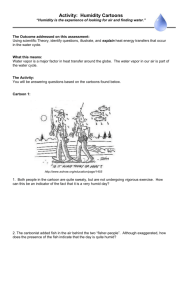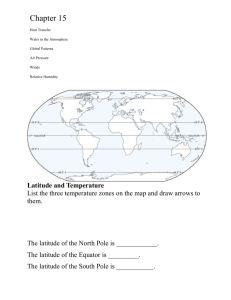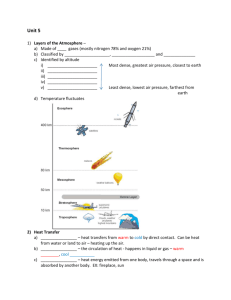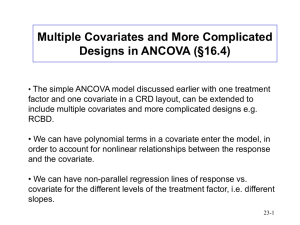Lesson #8: Humidity - Center for Learning in Action
advertisement
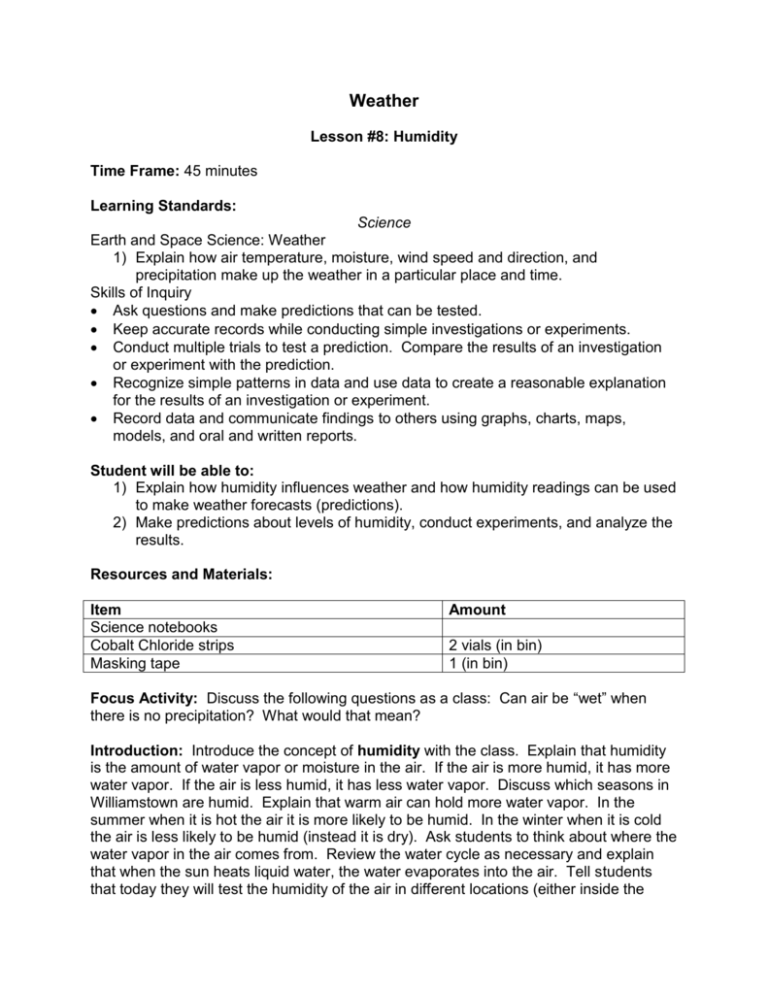
Weather Lesson #8: Humidity Time Frame: 45 minutes Learning Standards: Science Earth and Space Science: Weather 1) Explain how air temperature, moisture, wind speed and direction, and precipitation make up the weather in a particular place and time. Skills of Inquiry Ask questions and make predictions that can be tested. Keep accurate records while conducting simple investigations or experiments. Conduct multiple trials to test a prediction. Compare the results of an investigation or experiment with the prediction. Recognize simple patterns in data and use data to create a reasonable explanation for the results of an investigation or experiment. Record data and communicate findings to others using graphs, charts, maps, models, and oral and written reports. Student will be able to: 1) Explain how humidity influences weather and how humidity readings can be used to make weather forecasts (predictions). 2) Make predictions about levels of humidity, conduct experiments, and analyze the results. Resources and Materials: Item Science notebooks Cobalt Chloride strips Masking tape Amount 2 vials (in bin) 1 (in bin) Focus Activity: Discuss the following questions as a class: Can air be “wet” when there is no precipitation? What would that mean? Introduction: Introduce the concept of humidity with the class. Explain that humidity is the amount of water vapor or moisture in the air. If the air is more humid, it has more water vapor. If the air is less humid, it has less water vapor. Discuss which seasons in Williamstown are humid. Explain that warm air can hold more water vapor. In the summer when it is hot the air it is more likely to be humid. In the winter when it is cold the air is less likely to be humid (instead it is dry). Ask students to think about where the water vapor in the air comes from. Review the water cycle as necessary and explain that when the sun heats liquid water, the water evaporates into the air. Tell students that today they will test the humidity of the air in different locations (either inside the classroom, school, or outside). Remind the students to take careful notes in their science notebooks. Activity: 1) Break the students up into pairs to explore the humidity of two different locations in or around their school. Have students make a chart in their science journals that looks like the one below: Locations (2) Prediction: What Which location Which location Happened? How was more do you think will log did it take for humid? be more humid? each strip to turn pink? 2) Ask each group to make a prediction comparing the humidity of two different locations. Examples: The bathroom will be more humid that the classroom. The ceiling will be more humid than the floor. 3) Once the groups make a prediction, give them strips of cobalt chloride paper. Give each student a strip and then ask him or her to blow on it. Explain that the strips change color depending on the humidity of the air (strips change from blue to pink in humid conditions). 4) Assist the groups in taping the strips in the various locations. Remind the students to observe how fast the strips change color at both locations to determine which location is more humid. The more humid location should change the strip of paper from blue to pink more quickly. 5) Have students write down or draw a picture of what happened in their science notebooks. Ask groups to decide if their prediction was correct or incorrect based on their results. 6) Ask the different groups to share their predictions and results with the class and discuss reasons why certain locations may be more or less humid than others. 7) Discuss your daily weather data with the class. Do they notice any relationship between the weather and the humidity measurements? Do they notice any relationship between precipitation and humidity measurements? Closure: Discuss the following questions with the class. What is humidity? Where does the water vapor in the air come from? How does humid air feel? How does dry air feel? Assessment: Science notebook responses, participation in class activities and discussions, completion of the humidity experiments
